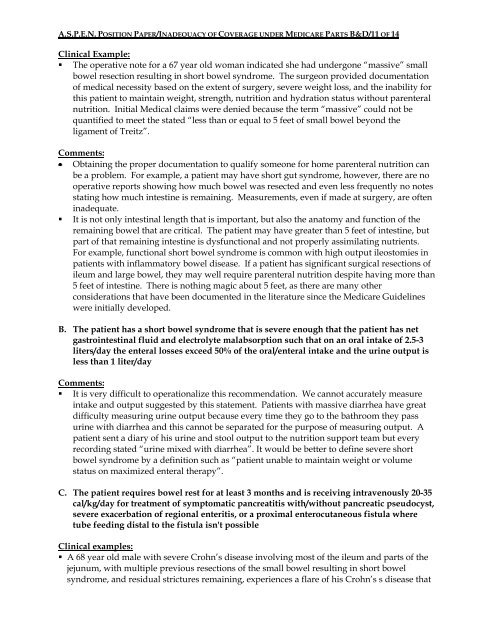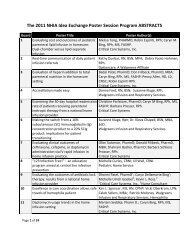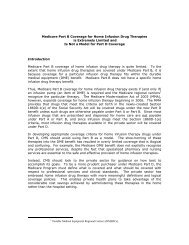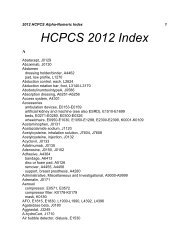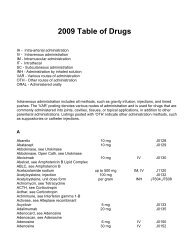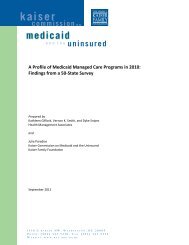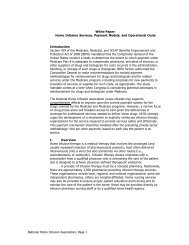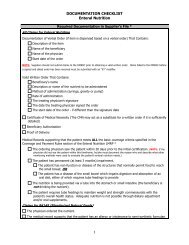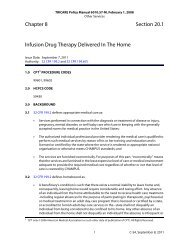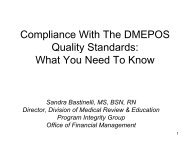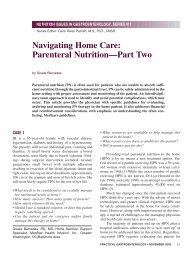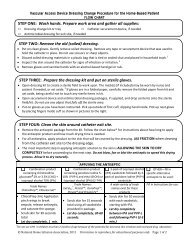Inadequacy of Coverage Under Medicare Part B and - NHIA
Inadequacy of Coverage Under Medicare Part B and - NHIA
Inadequacy of Coverage Under Medicare Part B and - NHIA
You also want an ePaper? Increase the reach of your titles
YUMPU automatically turns print PDFs into web optimized ePapers that Google loves.
A.S.P.E.N. POSITION PAPER/INADEQUACY OF COVERAGE UNDER MEDICARE PARTS B&D/11 OF 14<br />
Clinical Example:<br />
• The operative note for a 67 year old woman indicated she had undergone “massive” small<br />
bowel resection resulting in short bowel syndrome. The surgeon provided documentation<br />
<strong>of</strong> medical necessity based on the extent <strong>of</strong> surgery, severe weight loss, <strong>and</strong> the inability for<br />
this patient to maintain weight, strength, nutrition <strong>and</strong> hydration status without parenteral<br />
nutrition. Initial Medical claims were denied because the term “massive” could not be<br />
quantified to meet the stated “less than or equal to 5 feet <strong>of</strong> small bowel beyond the<br />
ligament <strong>of</strong> Treitz”.<br />
Comments:<br />
• Obtaining the proper documentation to qualify someone for home parenteral nutrition can<br />
be a problem. For example, a patient may have short gut syndrome, however, there are no<br />
operative reports showing how much bowel was resected <strong>and</strong> even less frequently no notes<br />
stating how much intestine is remaining. Measurements, even if made at surgery, are <strong>of</strong>ten<br />
inadequate.<br />
• It is not only intestinal length that is important, but also the anatomy <strong>and</strong> function <strong>of</strong> the<br />
remaining bowel that are critical. The patient may have greater than 5 feet <strong>of</strong> intestine, but<br />
part <strong>of</strong> that remaining intestine is dysfunctional <strong>and</strong> not properly assimilating nutrients.<br />
For example, functional short bowel syndrome is common with high output ileostomies in<br />
patients with inflammatory bowel disease. If a patient has significant surgical resections <strong>of</strong><br />
ileum <strong>and</strong> large bowel, they may well require parenteral nutrition despite having more than<br />
5 feet <strong>of</strong> intestine. There is nothing magic about 5 feet, as there are many other<br />
considerations that have been documented in the literature since the <strong>Medicare</strong> Guidelines<br />
were initially developed.<br />
B. The patient has a short bowel syndrome that is severe enough that the patient has net<br />
gastrointestinal fluid <strong>and</strong> electrolyte malabsorption such that on an oral intake <strong>of</strong> 2.5-3<br />
liters/day the enteral losses exceed 50% <strong>of</strong> the oral/enteral intake <strong>and</strong> the urine output is<br />
less than 1 liter/day<br />
Comments:<br />
• It is very difficult to operationalize this recommendation. We cannot accurately measure<br />
intake <strong>and</strong> output suggested by this statement. Patients with massive diarrhea have great<br />
difficulty measuring urine output because every time they go to the bathroom they pass<br />
urine with diarrhea <strong>and</strong> this cannot be separated for the purpose <strong>of</strong> measuring output. A<br />
patient sent a diary <strong>of</strong> his urine <strong>and</strong> stool output to the nutrition support team but every<br />
recording stated “urine mixed with diarrhea”. It would be better to define severe short<br />
bowel syndrome by a definition such as “patient unable to maintain weight or volume<br />
status on maximized enteral therapy”.<br />
C. The patient requires bowel rest for at least 3 months <strong>and</strong> is receiving intravenously 20-35<br />
cal/kg/day for treatment <strong>of</strong> symptomatic pancreatitis with/without pancreatic pseudocyst,<br />
severe exacerbation <strong>of</strong> regional enteritis, or a proximal enterocutaneous fistula where<br />
tube feeding distal to the fistula isn't possible<br />
Clinical examples:<br />
• A 68 year old male with severe Crohn’s disease involving most <strong>of</strong> the ileum <strong>and</strong> parts <strong>of</strong> the<br />
jejunum, with multiple previous resections <strong>of</strong> the small bowel resulting in short bowel<br />
syndrome, <strong>and</strong> residual strictures remaining, experiences a flare <strong>of</strong> his Crohn’s s disease that


